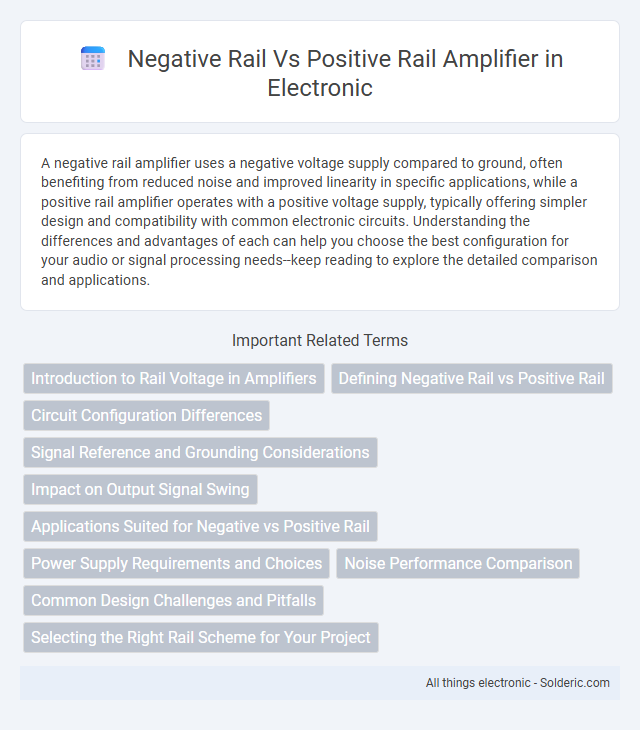A negative rail amplifier uses a negative voltage supply compared to ground, often benefiting from reduced noise and improved linearity in specific applications, while a positive rail amplifier operates with a positive voltage supply, typically offering simpler design and compatibility with common electronic circuits. Understanding the differences and advantages of each can help you choose the best configuration for your audio or signal processing needs--keep reading to explore the detailed comparison and applications.
Comparison Table
| Feature | Negative Rail Amplifier | Positive Rail Amplifier |
|---|---|---|
| Power Supply Reference | Uses negative voltage rail as reference (e.g., -Vcc) | Uses positive voltage rail as reference (e.g., +Vcc) |
| Input Signal Handling | Better handling of signals below ground potential | Optimized for signals above ground potential |
| Output Swing | Output swings from ground towards negative rail | Output swings from ground towards positive rail |
| Biasing Complexity | Requires biasing circuits to handle negative rail | Simpler biasing, often single supply operation |
| Application Example | Audio amplifiers with negative supply rails | Battery-powered or single-supply amps |
| Common Use Case | Dual-supply amplifier configurations | Single-supply amplifier configurations |
Introduction to Rail Voltage in Amplifiers
Rail voltage in amplifiers refers to the maximum voltage levels that power supply rails provide to the circuit, typically categorized as positive rail and negative rail. The positive rail offers the highest positive voltage, while the negative rail supplies the lowest negative voltage, both essential for defining the amplifier's output swing and signal handling capabilities. Understanding how your amplifier utilizes these voltages impacts its performance, efficiency, and signal distortion characteristics.
Defining Negative Rail vs Positive Rail
Negative rail and positive rail amplifiers differ primarily in their voltage supply configurations; a positive rail amplifier uses a single positive voltage supply relative to ground, while a negative rail amplifier operates with a negative voltage supply relative to ground. This difference affects how signals are biased, with negative rail amplifiers often enabling better handling of negative input voltages and improved signal swing in certain applications. Understanding your amplifier's rail type is crucial for optimizing circuit design and ensuring compatibility with your signal requirements.
Circuit Configuration Differences
Negative rail amplifiers use a power supply with a negative voltage reference, allowing the output to swing below ground potential, which is ideal for circuits requiring dual polarity. Positive rail amplifiers operate with a positive voltage reference, enabling the output to swing above ground, suitable for single-supply applications. Understanding your circuit's voltage requirements helps determine the appropriate configuration for optimal performance and signal fidelity.
Signal Reference and Grounding Considerations
Negative rail amplifiers reference the signal to the negative power supply, which requires careful grounding strategies to prevent noise and ground loops, ensuring signal integrity. Positive rail amplifiers typically reference the signal to the positive supply, often simplifying grounding but necessitating proper layout to avoid interference. Your choice impacts how grounding and signal reference are managed, affecting overall amplifier stability and noise performance.
Impact on Output Signal Swing
Negative rail amplifiers limit the output signal swing closer to the negative supply voltage, reducing the maximum achievable voltage range. Positive rail amplifiers extend the output swing near the positive supply voltage, allowing higher peak output voltages. The choice between negative and positive rail amplifiers directly affects the linearity and headroom of the output signal, influencing performance in high-fidelity audio and precision instrumentation applications.
Applications Suited for Negative vs Positive Rail
Negative rail amplifiers are commonly used in applications requiring precision signal processing in mixed-signal circuits and low-voltage battery-powered devices, where generating negative voltage rails is essential for proper operation. Positive rail amplifiers are best suited for single-supply systems such as audio amplification, sensor interfaces, and general-purpose signal conditioning where only a positive voltage rail is available. Choosing between negative and positive rail amplifiers depends on the power supply configuration and the required signal swing in the intended electronic application.
Power Supply Requirements and Choices
Negative rail amplifiers require dual power supplies typically ranging from +-15V to +-50V, providing symmetrical voltage rails essential for accurate signal amplification with minimal distortion. Positive rail amplifiers operate with a single positive supply, commonly from +5V to +24V, simplifying power supply design but often necessitating level shifting and careful biasing to accommodate signal swing. Selecting the appropriate power supply configuration depends on application constraints such as power efficiency, complexity, noise considerations, and the required output voltage range.
Noise Performance Comparison
Negative rail amplifiers typically exhibit lower noise performance due to their ability to maintain a more stable reference voltage, reducing noise contributions from power supply fluctuations. Positive rail amplifiers, while simpler in design, often suffer from increased noise levels as their output stage can introduce more voltage ripple and interference. Choosing the right amplifier depends on your noise sensitivity requirements and application environment.
Common Design Challenges and Pitfalls
Negative rail amplifiers often face challenges with increased distortion due to the asymmetric voltage swing and limited headroom, causing signal clipping and reduced linearity. Positive rail amplifiers typically encounter issues with power dissipation and thermal management since the output stage is referenced to the positive supply, resulting in higher heat generation under load. Both designs must carefully address biasing stability and the risk of crossover distortion to maintain consistent performance across varying signal conditions.
Selecting the Right Rail Scheme for Your Project
Selecting the right rail scheme for your amplifier depends on the power supply availability and signal swing requirements. Positive rail amplifiers simplify design by using a single supply but may limit output swing near ground, while negative rail amplifiers, typically requiring dual supplies, allow symmetrical signal swings and better headroom. Evaluate load impedance, noise tolerance, and cost constraints to determine whether a negative or positive rail configuration optimally suits your project's performance and efficiency goals.
negative rail vs positive rail amplifier Infographic

 solderic.com
solderic.com